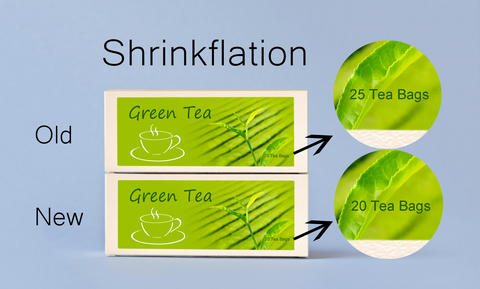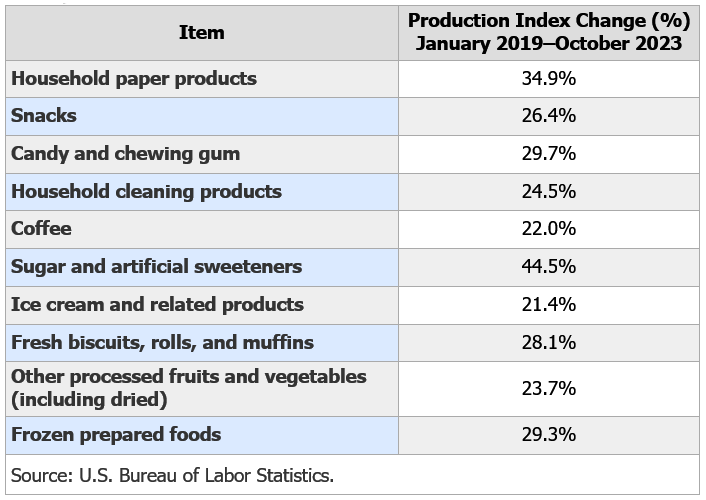Summary
Retailers benefit when unit price labeling best practices are implemented, including improvements for ordering, inventory control, and pricing accuracy, which enhances the shopping experience and saves the retailer money from reduced labor costs. Consumers use unit pricing for product value comparisons and to make informed decisions on what they are purchasing. "Shrinkflation" is a common term used to describe how consumer products are sold at the same price, but contents have been slightly reduced. NIST OWM provides resources for retailers and consumers, including NIST SP 1181, Unit Pricing Guide: A Best Practice Approach to Unit Pricing and A Guide to U.S. Retail Pricing Laws and Regulations.
Description
What is Unit Pricing?
The pricing of goods based on the cost per unit of measure is commonly known as unit pricing. A unit price label often displays the product name and size, the price, the price per unit (e.g., how much you pay per gram, liter, or ounce), and other information. Unit pricing is most frequently displayed as a label or sign on a retail store shelf (paper or digital). Unit pricing can also be found when shopping online on e-commerce sites.
A well-designed unit pricing label provides information to consumers with clear and unambiguous product price information. This enables the consumer to select the best quantity-price ratio and use that information to make an educated purchasing decision, especially when differentiating between the prices of similar products. See the series of retail store shelf labels in Figure 1 that are commonly encountered in the marketplace today. While not perfect, this series of labels does allow a consumer to make an informed choice regarding what to purchase that is irrespective of its "container" and based on a value comparison of inherent product characteristics. For example, in Figure 1, the product contains performance ingredients ("perf") or is certified as organic ("org").

Uniform Unit Pricing is Good for Retailers
Retailers benefit when unit price labeling best practices are implemented, including improved ordering, inventory control, and pricing accuracy. Unit pricing eliminates the need for individual item pricing (i.e., little price tag stickers), which saves the retailer money from reduced labor costs. Unit price labels may also be used to display certain kinds of nutritional information, such as low-sodium or high-fiber foods, and promote special programs such as the U.S. Department of Agriculture’s Women, Infants and Children (WIC). Unit pricing can provide the retailer with a competitive advantage by offering a means of customer service, satisfaction, and improved shopping experience.

Voluntary unit pricing has been in existence in the U.S. marketplace since the early 1970s and existing model unit pricing regulations can be found in NIST Handbook (HB) 130, Uniform Laws and Regulations. The Uniform Unit Pricing Regulation (UUPR) applies only when stores voluntarily provide unit pricing information. The UUPR has never included a mandatory provision. Currently, nineteen states and two territories have implemented unit pricing laws or regulations. Eleven of these jurisdictions have mandatory unit pricing provisions (e.g., Connecticut, Maryland, Massachusetts, New Hampshire, New Jersey, New York, Oregon, Puerto Rico, Rhode Island, Vermont, and the Virgin Islands). Thirty-four state jurisdictions do not have laws or regulations in place. NIST Handbook 130 currently permits retail stores to provide unit pricing in metric units. For additional information and a listing of state jurisdictions that adopt unit pricing laws and regulations, please refer to NIST Handbook 130, Chapter II (page 6).
What Can a Consumer Do?

Unit pricing is the best tool a consumer has when shopping. Savvy consumers can use simple consumer math to calculate unit pricing and determine product values to make informed value comparisons and purchasing decisions. In 2024, Purdue University researchers reported that 82 % of consumers use unit pricing when it is available. For example, 1.44 quarts (1.36 liters) of ice cream in a slightly smaller container are now commonly sold products in the grocery frozen section, compared with the 1.5 quarts (1.41 liters) of ice cream that was commonly found in stores just a few years back. Regular comments in popular culture also point to past times when the “half gallon” (i.e., 2 quarts) was the norm for ice cream products. Consumer Reports provides a helpful and short video explaining unit pricing to consumers.
What is Shrinkflation?

Many consumers across the U.S. are increasingly aware of the decreasing quantity of many of the products that they regularly purchase and consume. This concept is known as product downsizing or “shrinkflation,” a term used to describe how a consumer product is sold at the same price, but whose net contents have been reduced. Because it is difficult for consumers to monitor product quantity changes when shopping, how can they make the best purchasing decision when faced with changing package sizes?
The concept of shrinkflation was subsequently highlighted in news articles in CNN Business (February 11, 2024) and Packaging Digest (February 22, 2024), a trade journal for the packaging commercial industry. Last year, the U.S. Bureau of Labor Statistics published a comprehensive overview publication, “Getting less for the same price?” which demonstrated the general trends of a range of consumer items that have the highest instance of downsizing during the period of January 2015 to December 2021. Based on the Bureau of Labor Statistics analysis in 2023, approximately 30% of consumer goods have been downsized and likely affected by shrinkflation over the past 4 years (see summary within Table 1).

Product manufacturers have two choices when they need to accommodate increased production and transportation costs: 1) increase price or 2) downsize. Because consumers are sensitive to price changes, packers prefer to use downsizing as a method to account for increasing costs. From the consumer perspective, the chief complaint about shrinkflation stems from its prevalence in the marketplace and the perceived intent to deceive the consumer of changes (i.e., changes to a product net content without price changes).
How is NIST OWM Involved?
NIST OWM published SP 1181, Unit Pricing Guide: A Best Practice Approach to Unit Pricing, which provides a best practice approach to ensure that unit price labels are easy to read, informative, and understandable. This guidance was the result of a two-year collaboration among U.S. industry and consumer groups. Retailers and governments are encouraged to use the best practice guide to improve the accuracy and usability of unit pricing information offered in both retail stores and online to ensure uniformity across participating retailers and states.

NIST OWM has also established a National Legal Metrology Working Group on Unit Pricing to review and update the 2014 version of the NIST SP 1181 Unit Pricing Guide and will also consider the documentary standard language in NIST Handbook 130 Section IV. Uniform Regulations C. Uniform Unit Price Regulations and ensure that both documents are revised, harmonized, and ready for use and/or adoption by state regulators and industry. The working group members include representatives from industry, trade associations, academia, weights and measures regulatory officials, consumer groups, consumer advocates, and NIST OWM. Areas currently identified for review and consideration include electronic shelf labels, uniform e-commerce regulations, and any necessary updates to the language related to units of measure.
Learn More Here
- Unit Pricing Helps You Save (Consumer Reports Video)
- The Unit Price Is Right, NIST Taking Measure Blog
- New Best Practices Guide Shows Unit Pricing Is a Great Deal
- NIST SP 1181, Unit Pricing Guide: A Best Practice Approach to Unit Pricing
- A Guide to U.S. Retail Pricing Laws and Regulations
- Packaging and Labeling
- Weights and Measures Week
Research and References
- Purdue University, College of Agriculture, Center for Food Demand Analysis & Sustainability including the A Year in Review: 2023 CFDAS Annual Report.
- 118th Congress (2023-2024). Shrinkflation Prevention Act of 2024.
- Kachersky, K. Reduce Content or Raise Price? The Impact of Persuasion Knowledge and Unit Price Increase Tactics on Retailer and Product Brand Attitudes, J. of Retailing, Volume 87, Issue 4, 479-488 (2011).
- Yao, J., Oppewal, H. & Wang, D. Cheaper and smaller or more expensive and larger: how consumers respond to unit price increase tactics that simultaneously change product price and package size. J. of the Acad. Mark. Sci., Volume 48, 1075–1094 (2020).
In the News
- Attorney General Tong (CT) Seeks Legislation to Combat Shrinkflation, Price Gouging (CT.GOV; February 10, 2025)
- CBS News price tracker shows how much food, gas, utility and housing costs are rising (CBS News Money Watch; January 15, 2025)
- Shrinkflation has affected one-third of grocery items, analysis finds. Here are the worst offenders. (CBS News Money Watch; October 16, 2024)
- Is that cereal box getting smaller? Welcome to the bewildering world of shrinkflation. (USA Today; September 5, 2024)
- Shrinkflation 101: The Economics of Smaller Groceries (NY Times; March 1, 2024)

